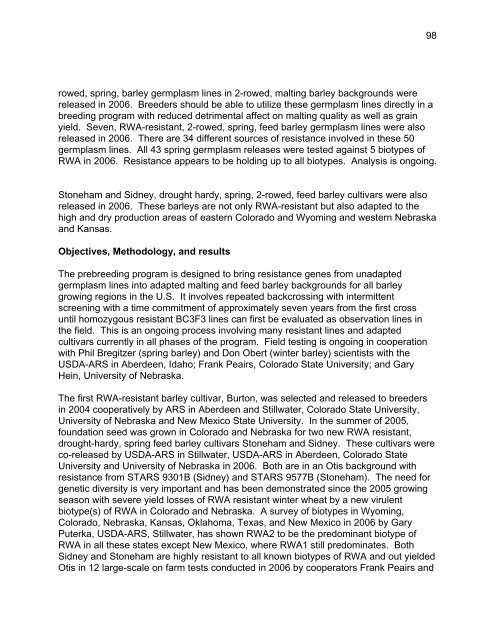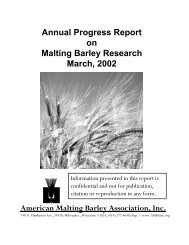Annual Progress Report on Malting Barley Research March, 2007
Annual Progress Report on Malting Barley Research March, 2007
Annual Progress Report on Malting Barley Research March, 2007
Create successful ePaper yourself
Turn your PDF publications into a flip-book with our unique Google optimized e-Paper software.
owed, spring, barley germplasm lines in 2-rowed, malting barley backgrounds were<br />
released in 2006. Breeders should be able to utilize these germplasm lines directly in a<br />
breeding program with reduced detrimental affect <strong>on</strong> malting quality as well as grain<br />
yield. Seven, RWA-resistant, 2-rowed, spring, feed barley germplasm lines were also<br />
released in 2006. There are 34 different sources of resistance involved in these 50<br />
germplasm lines. All 43 spring germplasm releases were tested against 5 biotypes of<br />
RWA in 2006. Resistance appears to be holding up to all biotypes. Analysis is <strong>on</strong>going.<br />
St<strong>on</strong>eham and Sidney, drought hardy, spring, 2-rowed, feed barley cultivars were also<br />
released in 2006. These barleys are not <strong>on</strong>ly RWA-resistant but also adapted to the<br />
high and dry producti<strong>on</strong> areas of eastern Colorado and Wyoming and western Nebraska<br />
and Kansas.<br />
Objectives, Methodology, and results<br />
The prebreeding program is designed to bring resistance genes from unadapted<br />
germplasm lines into adapted malting and feed barley backgrounds for all barley<br />
growing regi<strong>on</strong>s in the U.S. It involves repeated backcrossing with intermittent<br />
screening with a time commitment of approximately seven years from the first cross<br />
until homozygous resistant BC3F3 lines can first be evaluated as observati<strong>on</strong> lines in<br />
the field. This is an <strong>on</strong>going process involving many resistant lines and adapted<br />
cultivars currently in all phases of the program. Field testing is <strong>on</strong>going in cooperati<strong>on</strong><br />
with Phil Bregitzer (spring barley) and D<strong>on</strong> Obert (winter barley) scientists with the<br />
USDA-ARS in Aberdeen, Idaho; Frank Peairs, Colorado State University; and Gary<br />
Hein, University of Nebraska.<br />
The first RWA-resistant barley cultivar, Burt<strong>on</strong>, was selected and released to breeders<br />
in 2004 cooperatively by ARS in Aberdeen and Stillwater, Colorado State University,<br />
University of Nebraska and New Mexico State University. In the summer of 2005,<br />
foundati<strong>on</strong> seed was grown in Colorado and Nebraska for two new RWA resistant,<br />
drought-hardy, spring feed barley cultivars St<strong>on</strong>eham and Sidney. These cultivars were<br />
co-released by USDA-ARS in Stillwater, USDA-ARS in Aberdeen, Colorado State<br />
University and University of Nebraska in 2006. Both are in an Otis background with<br />
resistance from STARS 9301B (Sidney) and STARS 9577B (St<strong>on</strong>eham). The need for<br />
genetic diversity is very important and has been dem<strong>on</strong>strated since the 2005 growing<br />
seas<strong>on</strong> with severe yield losses of RWA resistant winter wheat by a new virulent<br />
biotype(s) of RWA in Colorado and Nebraska. A survey of biotypes in Wyoming,<br />
Colorado, Nebraska, Kansas, Oklahoma, Texas, and New Mexico in 2006 by Gary<br />
Puterka, USDA-ARS, Stillwater, has shown RWA2 to be the predominant biotype of<br />
RWA in all these states except New Mexico, where RWA1 still predominates. Both<br />
Sidney and St<strong>on</strong>eham are highly resistant to all known biotypes of RWA and out yielded<br />
Otis in 12 large-scale <strong>on</strong> farm tests c<strong>on</strong>ducted in 2006 by cooperators Frank Peairs and<br />
98
















